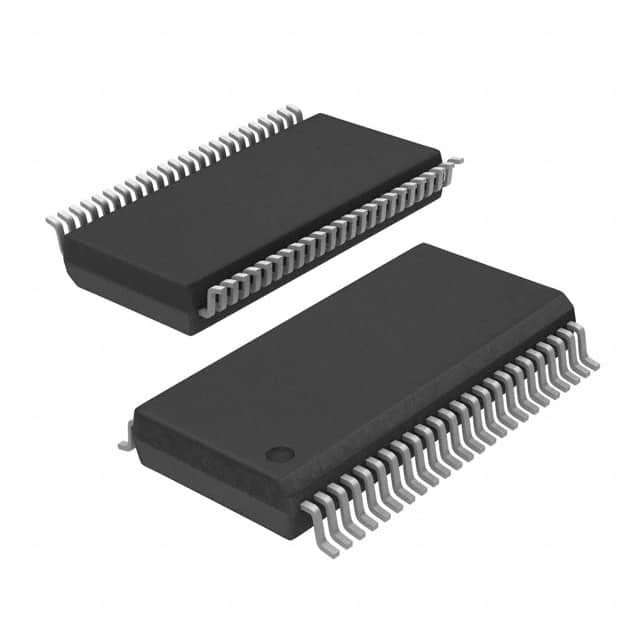Lihat spesifikasi untuk detail produk.

74LVC16374ADGG,112
Basic Information Overview
- Category: Integrated Circuit (IC)
- Use: Flip-Flop
- Characteristics: High-speed, low-power, 16-bit D-type flip-flop with 3-state outputs
- Package: TSSOP (Thin Shrink Small Outline Package)
- Essence: Sequential logic device for storing and transferring binary data
- Packaging/Quantity: Tape and reel packaging, 2500 units per reel
Specifications
- Supply Voltage Range: 1.2V to 3.6V
- Input Voltage Range: -0.5V to VCC + 0.5V
- Output Voltage Range: 0V to VCC
- Operating Temperature Range: -40°C to +125°C
- Output Drive Capability: ±24mA at 3.0V
- Propagation Delay: 4.5ns (typical) at 3.3V, 50pF load
Detailed Pin Configuration
The 74LVC16374ADGG,112 IC has a total of 48 pins. The pin configuration is as follows:
+-------------------+
OE --|1 48|-- VCC
CP1 --|2 47|-- GND
CP2 --|3 46|-- Q0
CP3 --|4 45|-- Q1
CP4 --|5 44|-- Q2
CP5 --|6 43|-- Q3
CP6 --|7 42|-- Q4
CP7 --|8 41|-- Q5
CP8 --|9 40|-- Q6
CP9 --|10 39|-- Q7
CP10 --|11 38|-- Q8
CP11 --|12 37|-- Q9
CP12 --|13 36|-- Q10
CP13 --|14 35|-- Q11
CP14 --|15 34|-- Q12
CP15 --|16 33|-- Q13
CP16 --|17 32|-- Q14
GND --|18 31|-- Q15
D0 --|19 30|-- OE#
D1 --|20 29|-- D15
D2 --|21 28|-- D14
D3 --|22 27|-- D13
D4 --|23 26|-- D12
D5 --|24 25|-- D11
+-------------------+
Functional Features
- High-speed operation: The 74LVC16374ADGG,112 offers fast data transfer and clocking capabilities, making it suitable for high-performance applications.
- Low-power consumption: This IC is designed to minimize power consumption, making it ideal for battery-powered devices or energy-efficient systems.
- 3-state outputs: The 74LVC16374ADGG,112 features 3-state outputs, allowing multiple devices to be connected to a common bus without interference.
Advantages and Disadvantages
Advantages: - High-speed operation enables efficient data processing. - Low-power consumption prolongs battery life in portable devices. - 3-state outputs facilitate bus sharing in complex systems.
Disadvantages: - Limited voltage range (1.2V to 3.6V) may not be compatible with all applications. - TSSOP package may require careful handling during assembly.
Working Principles
The 74LVC16374ADGG,112 is a positive-edge-triggered flip-flop that stores and transfers binary data. It operates based on clock signals and data inputs. When the clock signal transitions from low to high (rising edge), the input data is latched and stored in the flip-flop. The stored data is then available at the output pins until the next clock cycle.
Detailed Application Field Plans
The 74LVC16374ADGG,112 IC finds applications in various fields, including: 1. Microprocessor systems: Used for data storage and transfer between the microprocessor and peripherals. 2. Communication systems: Facilitates data buffering and synchronization in communication protocols. 3. Industrial automation: Enables control and monitoring of devices in industrial processes. 4. Automotive electronics: Supports data handling in automotive control units and infotainment systems. 5. Consumer electronics: Utilized in digital TVs, set-top boxes, gaming consoles, etc., for data processing.
Detailed and Complete Alternative Models
Some alternative models that can be considered as alternatives to the 74LVC16374ADGG,112 are: - SN74LVC16374ADGGR - MC74LVC16374ADG - CD74LVC16374ADGG
Sebutkan 10 pertanyaan dan jawaban umum terkait penerapan 74LVC16374ADGG,112 dalam solusi teknis
Sure! Here are 10 common questions and answers related to the application of 74LVC16374ADGG,112:
Q: What is the function of the 74LVC16374ADGG,112? A: The 74LVC16374ADGG,112 is a 16-bit D-type flip-flop with 3-state outputs. It can store and transfer data in digital circuits.
Q: What is the operating voltage range for the 74LVC16374ADGG,112? A: The operating voltage range for this IC is typically between 1.65V and 5.5V.
Q: How many flip-flops are there in the 74LVC16374ADGG,112? A: The 74LVC16374ADGG,112 contains 16 individual D-type flip-flops.
Q: What is the maximum clock frequency supported by the 74LVC16374ADGG,112? A: The maximum clock frequency supported by this IC is typically around 125 MHz.
Q: Can the 74LVC16374ADGG,112 be used for bidirectional data transfer? A: Yes, the 74LVC16374ADGG,112 supports bidirectional data transfer, allowing data to be input or output from any side.
Q: What is the power consumption of the 74LVC16374ADGG,112? A: The power consumption of this IC depends on various factors such as supply voltage, clock frequency, and load conditions. Please refer to the datasheet for detailed information.
Q: Does the 74LVC16374ADGG,112 have built-in protection features? A: Yes, this IC has built-in protection features such as overvoltage and undervoltage lockout, preventing damage to the device in case of voltage fluctuations.
Q: Can I cascade multiple 74LVC16374ADGG,112 ICs together? A: Yes, you can cascade multiple 74LVC16374ADGG,112 ICs together to increase the number of flip-flops or create larger data storage systems.
Q: What is the output drive strength of the 74LVC16374ADGG,112? A: The output drive strength of this IC is typically around 24 mA, allowing it to drive moderate loads.
Q: Are there any specific layout considerations for using the 74LVC16374ADGG,112? A: Yes, it is recommended to follow proper PCB layout guidelines to minimize noise, ensure signal integrity, and optimize performance. Please refer to the datasheet for detailed layout recommendations.
Please note that these answers are general and may vary depending on the specific application and requirements. It is always advisable to consult the datasheet and relevant technical documentation for accurate information.

